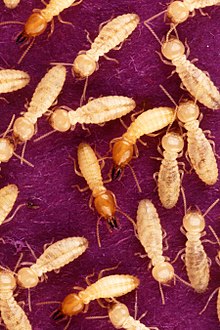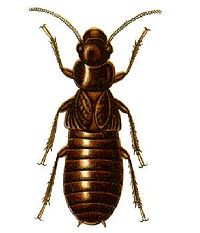
A | B | C | D | E | F | G | H | CH | I | J | K | L | M | N | O | P | Q | R | S | T | U | V | W | X | Y | Z | 0 | 1 | 2 | 3 | 4 | 5 | 6 | 7 | 8 | 9
| Termite Temporal range:
| |
|---|---|

| |
| Formosan subterranean termite (Coptotermes formosanus) Soldiers (red-coloured heads) Workers (pale-coloured heads) | |
| Scientific classification | |
| Domain: | Eukaryota |
| Kingdom: | Animalia |
| Phylum: | Arthropoda |
| Class: | Insecta |
| Cohort: | Polyneoptera |
| Superorder: | Dictyoptera |
| Order: | Blattodea |
| Infraorder: | Isoptera Brullé, 1832 |
| Families | |
| |
Termites are a group of detritophagous eusocial insects which consume a wide variety of decaying plant material, generally in the form of wood, leaf litter, and soil humus. They are distinguished by their moniliform antennae and the soft-bodied and often unpigmented worker caste for which they have been commonly termed "white ants"; however, they are not ants, to which they are distantly related.[3] About 2,972 extant species are currently described, 2,105 of which are members of the family Termitidae.
Termites comprise the infraorder Isoptera, or alternatively the epifamily Termitoidae, within the order Blattodea (along with cockroaches). Termites were once classified in a separate order from cockroaches, but recent phylogenetic studies indicate that they evolved from cockroaches, as they are deeply nested within the group, and the sister group to wood eating cockroaches of the genus Cryptocercus. Previous estimates suggested the divergence took place during the Jurassic or Triassic. More recent estimates suggest that they have an origin during the Late Jurassic,[4] with the first fossil records in the Early Cretaceous.
Similarly to ants and some bees and wasps from the separate order Hymenoptera, most termites have an analogous "worker" and "soldier" caste system consisting of mostly sterile individuals which are physically and behaviorally distinct. Unlike ants, most colonies begin from sexually mature individuals known as the "king" and "queen" that together form a lifelong monogamous pair.[5] Also unlike ants, which undergo a complete metamorphosis, termites undergo an incomplete metamorphosis that proceeds through egg, nymph, and adult stages. Termite colonies are commonly described as superorganisms due to the collective behaviors of the individuals which form a self-governing entity: the colony itself.[6] Their colonies range in size from a few hundred individuals to enormous societies with several million individuals. Most species are rarely seen, having a cryptic life-history where they remain hidden within the galleries and tunnels of their nests for most of their lives.
Termites' success as a group has led to them colonizing almost every global landmass, with the highest diversity occurring in the tropics where they are estimated to constitute 10% of the animal biomass, particularly in Africa which has the richest diversity with more than 1000 described species.[7] They are important decomposers of decaying plant matter in the subtropical and tropical regions of the world, and their recycling of wood and plant matter is of considerable ecological importance. Many species are ecosystem engineers capable of altering soil characteristics such as hydrology, decomposition, nutrient cycling, vegetative growth, and consequently surrounding biodiversity through the large mounds constructed by certain species.[8]
Termites have several impacts on humans. They are a delicacy in the diet of some human cultures such as the Makiritare in the Alto Orinoco province of Venezuela, where they are commonly used as a spice.[9] They are also used in traditional medicinal treatments of various diseases and ailments, such as influenza, asthma, bronchitis, etc.[10][11] Termites are most famous for being structural pests; however, the vast majority of termite species are innocuous, with the regional numbers of economically significant species being: North America, 9; Australia, 16; Indian subcontinent, 26; tropical Africa, 24; Central America and the West Indies, 17. Of known pest species, 28 of the most invasive and structurally damaging belong to the genus Coptotermes.[12] The distribution of most known pest species is expected to increase over time as a consequence of climate change.[13]
Etymology
The infraorder name Isoptera is derived from the Greek words iso (equal) and ptera (winged), which refers to the nearly equal size of the fore and hind wings.[14] "Termite" derives from the Latin and Late Latin word termes ("woodworm, white ant"), altered by the influence of Latin terere ("to rub, wear, erode") from the earlier word tarmes. A termite nest is also known as a termitary or termitarium (plural termitaria or termitariums).[15] In earlier English, termites were known as "wood ants" or "white ants".[16] The modern term was first used in 1781.[17]
Taxonomy and evolution

Termites were formerly placed in the order Isoptera. As early as 1934 suggestions were made that they were closely related to wood-eating cockroaches (genus Cryptocercus, the woodroach) based on the similarity of their symbiotic gut flagellates.[18] In the 1960s additional evidence supporting that hypothesis emerged when F. A. McKittrick noted similar morphological characteristics between some termites and Cryptocercus nymphs.[19] In 2008 DNA analysis from 16S rRNA sequences[20] supported the position of termites being nested within the evolutionary tree containing the order Blattodea, which included the cockroaches.[21][22] The cockroach genus Cryptocercus shares the strongest phylogenetical similarity with termites and is considered to be a sister-group to termites.[23][24] Termites and Cryptocercus share similar morphological and social features: for example, most cockroaches do not exhibit social characteristics, but Cryptocercus takes care of its young and exhibits other social behaviour such as trophallaxis and allogrooming.[25] Termites are thought to be the descendants of the genus Cryptocercus.[21][26] Some researchers have suggested a more conservative measure of retaining the termites as the Termitoidae, an epifamily within the cockroach order, which preserves the classification of termites at family level and below.[27] Termites have long been accepted to be closely related to cockroaches and mantids, and they are classified in the same superorder (Dictyoptera).[28][29]
The oldest unambiguous termite fossils date to the early Cretaceous, but given the diversity of Cretaceous termites and early fossil records showing mutualism between microorganisms and these insects, they possibly originated earlier in the Jurassic or Triassic.[30][31][32] Possible evidence of a Jurassic origin is the assumption that the extinct mammaliaform Fruitafossor from Morrison Formation consumed termites, judging from its morphological similarity to modern termite-eating mammals.[33] Morrison Formation also yields social insect nest fossils close to that of termites.[34] The oldest termite nest discovered is believed to be from the Upper Cretaceous in West Texas, where the oldest known faecal pellets were also discovered.[35] Claims that termites emerged earlier have faced controversy. For example, F. M. Weesner indicated that the Mastotermitidae termites may go back to the Late Permian, 251 million years ago,[36] and fossil wings that have a close resemblance to the wings of Mastotermes of the Mastotermitidae, the most primitive living termite, have been discovered in the Permian layers in Kansas.[37] It is even possible that the first termites emerged during the Carboniferous.[38] The folded wings of the fossil wood roach Pycnoblattina, arranged in a convex pattern between segments 1a and 2a, resemble those seen in Mastotermes, the only living insect with the same pattern.[37] Kumar Krishna et al., though, consider that all of the Paleozoic and Triassic insects tentatively classified as termites are in fact unrelated to termites and should be excluded from the Isoptera.[39] Other studies suggest that the origin of termites is more recent, having diverged from Cryptocercus sometime during the Early Cretaceous.[4]

The primitive giant northern termite (Mastotermes darwiniensis) exhibits numerous cockroach-like characteristics that are not shared with other termites, such as laying its eggs in rafts and having anal lobes on the wings.[40] It has been proposed that the Isoptera and Cryptocercidae be grouped in the clade "Xylophagodea".[41] Termites are sometimes called "white ants", but the only resemblance to the ants is due to their sociality which is due to convergent evolution[42][43] with termites being the first social insects to evolve a caste system more than 100 million years ago.[44] Termite genomes are generally relatively large compared to those of other insects; the first fully sequenced termite genome, of Zootermopsis nevadensis, which was published in the journal Nature Communications, consists of roughly 500Mb,[45] while two subsequently published genomes, Macrotermes natalensis and Cryptotermes secundus, are considerably larger at around 1.3Gb.[46][43]
External phylogeny showing relationship of termites with other insect groups:[47]
| Dictyoptera |
| ||||||||||||||||||||||||||||||||||||
Internal phylogeny showing relationship of extant termite families:[48][49]
